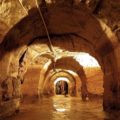Lisbon’s cathedral, Sé de Lisboa, is one of the city’s most iconic monuments and it has been attracting people through ages.
Its history began in the year of 1147 when D. Afonso Henriques, Portugal’s first king, reconquered Lisbon. The city had been under moorish influence for almost four centuries.
It was by that time that, as a way of reinforcing the presence of the catholics and their victory over the moorish, Portuguese people started to build a cathedral on the same place where once stood the main mosque of Lisbon.
The first building was completed between 1147 and the first decades of the 13th century in romanesque style but Sé de Lisboa kept growing and evolving over the following centuries. By the 20th century the building managed to be an harmonious combinations of gothic elements, neoclassical influences and rococo details.
In its latest renovation, in the beginning of the 20th century, much of the neoclassical elements, both from the outside and the inside, ended up being removed to give the cathedral the more “mediaeval” appearance with the two towers and beautiful rosace window on the façade that we know today.
It is also known as Igreja de Santa Maria Maior and besides the aisles, the main chapel, the adjacent chapels and the transept, one can also visit the gothic cloisters, the excavations beneath the cloister and the church’s treasures.
If you look left after stepping in through the main entrance, you can also spot the baptismal font where Santo António, Lisbon’s dearest saint, is said to have been baptized in 1195.

Sé de Lisboa
> Largo da Sé, Lisboa
> Opens Monday to Saturday 9h-19h and Sunday 9h-20h
> Free entrance, except for visiting the cloisters and the churche’s treasures. Combined ticket giving access to the cloisters and treasures: 4€
> Insider tip: Sé de Lisboa has 3 organs from different eras and from time to time it is possible to listen to them, majestically playing, since concerts still take place in the cathedral.





